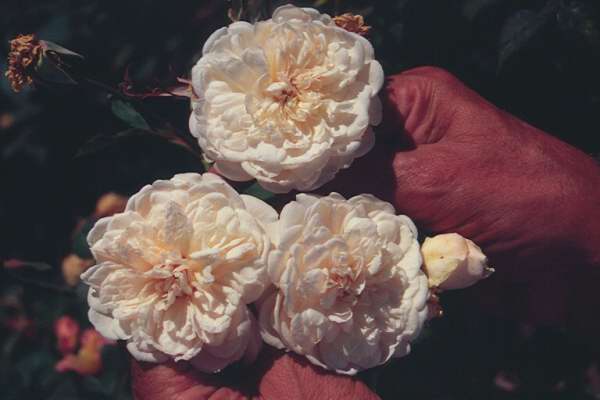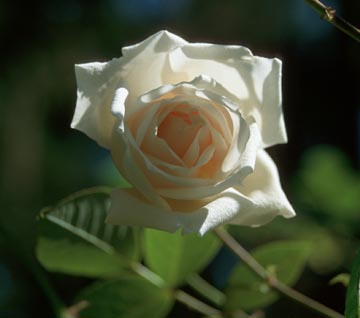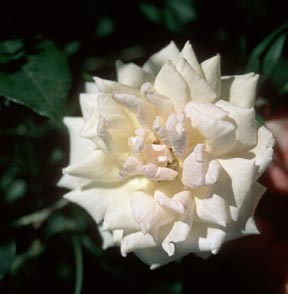Tea Rose Misidentification
 Many of the old tea roses currently being sold are plants which have been found in old gardens or cemeteries and identified by various rosarians as a specific tea rose. They are then propagated and sold under that name, first by one nursery, and eventually by many nurseries. When the plant has been misidentified, the error is passed on until a large number of people are buying the wrong plant. For years I have heard that Sombreuil is not the original plant sold under that name.(There is more on Sombreuil further down on this page.) Recently Mel Hulse showed me a plant of Colonial White (1959 LCL by Wyant), which looks just like all the plants of Sombreuil I have seen. I had Mel hold a flower of Colonial White above two flowers of Sombreuil while I took a picture:
Many of the old tea roses currently being sold are plants which have been found in old gardens or cemeteries and identified by various rosarians as a specific tea rose. They are then propagated and sold under that name, first by one nursery, and eventually by many nurseries. When the plant has been misidentified, the error is passed on until a large number of people are buying the wrong plant. For years I have heard that Sombreuil is not the original plant sold under that name.(There is more on Sombreuil further down on this page.) Recently Mel Hulse showed me a plant of Colonial White (1959 LCL by Wyant), which looks just like all the plants of Sombreuil I have seen. I had Mel hold a flower of Colonial White above two flowers of Sombreuil while I took a picture:

 More recently, Greg Lowery and Phillip Robinson of Vintage Gardens found that a rose which had been misidentified as La Biche was identical to the plant of Mlle de Sombreuil growing at the Roserie de l'Hay near Paris. It looks much more like the old descriptions I've read. Here are a couple pictures of it that I took in Charleston. You can also see a picture on the Vintage Gardens website.
More recently, Greg Lowery and Phillip Robinson of Vintage Gardens found that a rose which had been misidentified as La Biche was identical to the plant of Mlle de Sombreuil growing at the Roserie de l'Hay near Paris. It looks much more like the old descriptions I've read. Here are a couple pictures of it that I took in Charleston. You can also see a picture on the Vintage Gardens website.


 Another misidentification was brought to my attention by Ed Wilkinson. I was looking at Francis Dubreuil, and he took me over to show me Barcelona, a 1932 hybrid tea from Kordes. Again, there is no difference. Here is my picture of Barcelona (unfortunately, the film I used doesn't show the deep, dark velvety red color as well as I would like.):
Another misidentification was brought to my attention by Ed Wilkinson. I was looking at Francis Dubreuil, and he took me over to show me Barcelona, a 1932 hybrid tea from Kordes. Again, there is no difference. Here is my picture of Barcelona (unfortunately, the film I used doesn't show the deep, dark velvety red color as well as I would like.):

There are many other misidentified tea roses. Plants of Souvenir de J. B. Guillot and Clemontina Carbonieri are identical. One is probably correct, the other confused. Their old descriptions are similar, but the former should show some nasturtium red shadings in hot weather, the latter should have violet shaded edges. Mons. Tillier is very confused with Archduke Joseph. Old descriptions mention a copper center for Archduke Joseph, but not for Mons. Tillier, but much of the time, neither has a copper center and they can look alike. I don't have any idea what the rose sold as Mme. de Tartas is, except that it isn't Mme de Tartas, which should be a very pale pink rose. Souvenir d'un Ami is another lovely tea rose, but is not the real Souvenir d'un Ami. I have another candidate for that title which I received as a cutting from Bill Grant. I got the shock of my life when my plant first bloomed. It smelled like Lipton's tea! Of the hundreds of tea roses I've smelled, that was the first that had no hint of that sweet, light fragrance we associate with tea roses. It really smelled of tea! Gregg Lowery and Phillip Robinson should be commended for their catalog write-ups. They are very clear about their sources, and doubts as to the identity of the roses Vintage Gardens sells. You can read about several other misidentified teas there.
�
More on Sombreuil/Mlle de Sombreuil
This is a summary of Virginia Hopper's article on Sombreuil
which was published in the OGR & Shrub Gazette in 1996, with comments on Colonial White added by this author.
Back in the 1930s, a woman named Evelyn Keays found and identified many old roses. She frequently wrote articles for the Rose Annual about old roses. According to Ms. Hopper's article, it was Mrs. Keays who found the climber shown in the picture at the top of this page and misidentified it as Sombreuil. Early written descriptions of Mlle de Sombreuil mention a Bourbon influence, and fit the description of the foundling well enough to convince her that she had found that rose. Here is Mrs. Keays description of it:
"Sombreuil, 1851, came from a fine old garden sadly out of past glory. This rose differs from all those preceding by having a marked and distinguishable mixture of bourbon blood in the tea rose ancestry. The full, fragrant bloom is a fine expanded form, within which very strongly textured petals stand in excellent order and stiffness, making a grand rose of creamy white tinted with pale pink or pinkish white, depending on the weather, becoming white eventually and lasting in form a long time; blooming in large clusters on a very sturdy bush with deep green foliage, quite leathery and more deeply serrate than the pure tea foliage. Sombreuil with all this resistant toughness, should be the finest white tea rose of the garden, and is such in dry, clear sunny weather but a too moist spring causes the blooms to ball badly."
During the 1930s and 1940s, few other people were researching old roses. One other person was Francis E. Lester who started Roses of Yesterday near Watsonville, California. Virginia Hopper believes that Mrs. Keays supplied propagating material to Lester, because his nursery started selling this misidentified Sombreuil in 1947. Here is their catalog description:
"Sombreuil, Tea (1851). We again page Mrs. Keays, to describe with clarity, a distinguished old favorite. 'This rose has a marked mixture of bourbon blood in the tea. But a too moist spring causes the blooms to ball badly.'"
In the late 1950s, Dorothy Stemler, who owned Roses of Yesterday at that time, sent propagating material of the misidentified Sombreuil to Graham Stuart Thomas. From there the rose has traveled around the world.
The rose known as Colonial White is certainly an imposter for it is the same rose as the misidentified Sombreuil. The parentage given for it [New Dawn x Mme Hardy] must be a guess on the part of Wyant, the person who introduced it in 1959 as if it were a new rose.
Phillip Robinson, of Vintage Gardens, in his investigation of another found rose, discovered that it is identical to the rose labeled Mlle de Sombreuil at Roserie de l'Hay in Paris. It fits the descriptions of Sombreuil- behaving much more like a tea rose that the misidentified one does. Further, the photo of Mlle de Sombreuil in their online catalogue looks like the drawing of the real rose shown in Brent Dickerson's book, "The Old Rose Adventurer."
A recent discussion with some rosarians familiar with Mrs Keays writings disputes the idea that she was the one who made the error in identification. It would be unlike her to confuse the characteristics of "Sombreuil" with those of the tea rose 'Mlle. de Sombreuil'. She was very knowledgeable of leaf shapes and other details that help identify a rose. (Virginia Hopper's article also mentions this, but added that she might have been influenced by knowing that there was a bourbon in Mlle de Sombreuil's ancestry, and not having found a bourbon that matched her foundling, she looked for roses that were part bourbon.) It is possible she sent a package to Francis Lester containing cuttings from a number of roses, and labels got mixed, 'Mlle de Sombreuil' didn't survive and "Sombreuil" did, or some similar accident occurred which caused the mixup. Lester died between the time of receiving "Sombreuil", and when it was released in their catalog, the company having been carried on by his wife and Will Tillotson.
So, what is the misidentified "Sombreuil"? At this point, no one knows. It is certainly not a tea, and therefore should be labeled: "Sombreuil", found, LCl.
- Jill Perry
back to main page
 Many of the old tea roses currently being sold are plants which have been found in old gardens or cemeteries and identified by various rosarians as a specific tea rose. They are then propagated and sold under that name, first by one nursery, and eventually by many nurseries. When the plant has been misidentified, the error is passed on until a large number of people are buying the wrong plant. For years I have heard that Sombreuil is not the original plant sold under that name.(There is more on Sombreuil further down on this page.) Recently Mel Hulse showed me a plant of Colonial White (1959 LCL by Wyant), which looks just like all the plants of Sombreuil I have seen. I had Mel hold a flower of Colonial White above two flowers of Sombreuil while I took a picture:
Many of the old tea roses currently being sold are plants which have been found in old gardens or cemeteries and identified by various rosarians as a specific tea rose. They are then propagated and sold under that name, first by one nursery, and eventually by many nurseries. When the plant has been misidentified, the error is passed on until a large number of people are buying the wrong plant. For years I have heard that Sombreuil is not the original plant sold under that name.(There is more on Sombreuil further down on this page.) Recently Mel Hulse showed me a plant of Colonial White (1959 LCL by Wyant), which looks just like all the plants of Sombreuil I have seen. I had Mel hold a flower of Colonial White above two flowers of Sombreuil while I took a picture:


